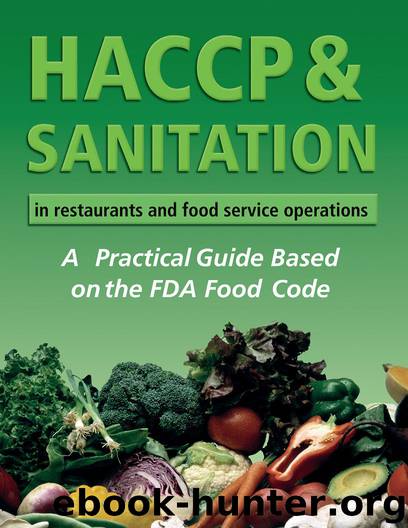HACCP & Sanitation in Restaurants and Food Service Operations: A Practical Guide Based on the USDA Food Code by Lora Arduser & Douglas R Brown

Author:Lora Arduser & Douglas R Brown
Language: eng
Format: epub
Tags: FDA, food code, food service, food safety, HACCP, sanitation, hygiene, samples forms
Publisher: Atlantic Publishing
Published: 2013-05-03T00:00:00+00:00
Cooking
Enteric pathogens
Cooking sufficiently to kill enteric pathogens
When working with flow charts, you need to do the following:
• Identify potentially hazardous foods. While any food item has the potential for contamination, meats, poultry, fish, eggs and dairy products are most likely to be implicated in a food-borne illness outbreak.
• Identify ready-to-eat foods. Ready-to-eat foods may become contaminated during storage or food handling, so you must identify what kind of contamination might occur with these foods.
• Determine the severity or seriousness of the hazard. How serious and how likely is it that the hazard will occur? Mishandling of raw meat and the risk of cross-contamination by raw meat is a distinct possibility and could be potentially very dangerous. The HACCP team should decide which hazards should be addressed in the HACCP plan.
Principle #2: Identifying Critical Control Points
Critical control points are the points during receiving, storing, preparation and serving when potential hazards can be controlled or prevented. Examples of CCPs are thoroughly cooking items to proper minimum internal temperatures, cooling items properly, establishing and following time and temperature controls, prevention of cross-contamination, and certain aspects of employee and environmental hygiene. For example, cooking that must occur at a specific temperature and for a specified time in order to destroy microbiological pathogens is a CCP. Likewise, refrigeration or the adjustment of a food’s pH to a level required to prevent hazardous microorganisms from multiplying or toxins from forming are also CCPs.
If we use our example, a grilled chicken sandwich, we know that chicken sandwiches are usually cooked to order and not held for extended periods. Therefore, hot holding and cooling are not typically issues. The CCPs occur during receiving, storing, preparation and cooking. Raw meats can contaminate ready-to-eat foods and food surfaces, so you must be careful to avoid cross-contamination. In addition, the meat must be properly cooked to kill any bacteria present.
To develop CCPs, you must develop procedures to prevent, reduce and eliminate hazards. The requirements you establish must be measurable and observable, and they must meet the state standards.
Many points in food preparation may be considered control points, but very few are actually critical control points. A control point is any point, step or procedure at which biological, physical or chemical factors can be controlled. Concerns that do not impact food safety may be addressed at control points; however, since these control points do not relate to food safety, they are not included in the HACCP plan.
Different facilities preparing the same food can differ in the risk of hazards and the points, steps or procedures which are CCPs. This can be due to differences in each facility such as layout, equipment, selection of ingredients or the process that is used. Generic HACCP plans can serve as useful guides; however, it is essential that the unique conditions within each facility be considered during the development of a HACCP plan.
CCPs must be carefully developed and documented. In addition, they must be used only for purposes of product safety.
The decision tree on the following page is helpful in verifying which of the food preparation steps should be designated as CCPs.
Download
This site does not store any files on its server. We only index and link to content provided by other sites. Please contact the content providers to delete copyright contents if any and email us, we'll remove relevant links or contents immediately.
Whiskies Galore by Ian Buxton(41867)
Introduction to Aircraft Design (Cambridge Aerospace Series) by John P. Fielding(33064)
Small Unmanned Fixed-wing Aircraft Design by Andrew J. Keane Andras Sobester James P. Scanlan & András Sóbester & James P. Scanlan(32743)
Craft Beer for the Homebrewer by Michael Agnew(18140)
Turbulence by E. J. Noyes(7935)
The Complete Stick Figure Physics Tutorials by Allen Sarah(7307)
Kaplan MCAT General Chemistry Review by Kaplan(6866)
The Thirst by Nesbo Jo(6826)
Bad Blood by John Carreyrou(6543)
Modelling of Convective Heat and Mass Transfer in Rotating Flows by Igor V. Shevchuk(6391)
Learning SQL by Alan Beaulieu(6208)
Weapons of Math Destruction by Cathy O'Neil(6139)
Man-made Catastrophes and Risk Information Concealment by Dmitry Chernov & Didier Sornette(5921)
Digital Minimalism by Cal Newport;(5661)
Life 3.0: Being Human in the Age of Artificial Intelligence by Tegmark Max(5474)
iGen by Jean M. Twenge(5366)
Secrets of Antigravity Propulsion: Tesla, UFOs, and Classified Aerospace Technology by Ph.D. Paul A. Laviolette(5309)
Design of Trajectory Optimization Approach for Space Maneuver Vehicle Skip Entry Problems by Runqi Chai & Al Savvaris & Antonios Tsourdos & Senchun Chai(5011)
Electronic Devices & Circuits by Jacob Millman & Christos C. Halkias(4907)
